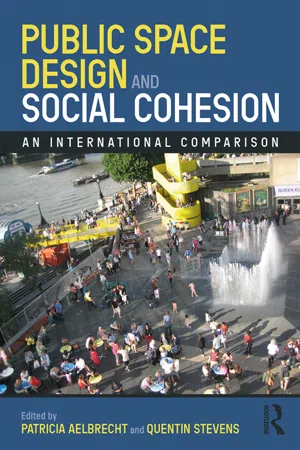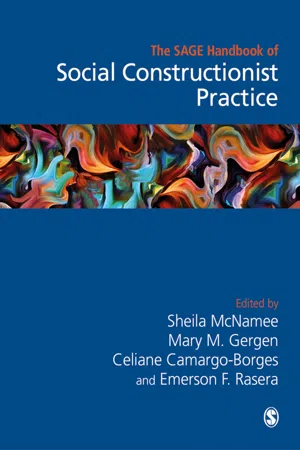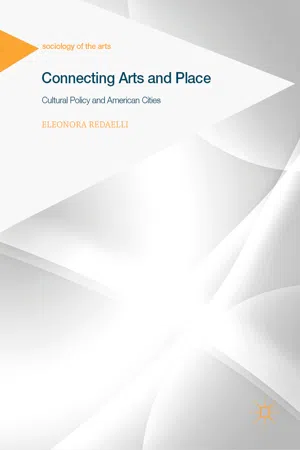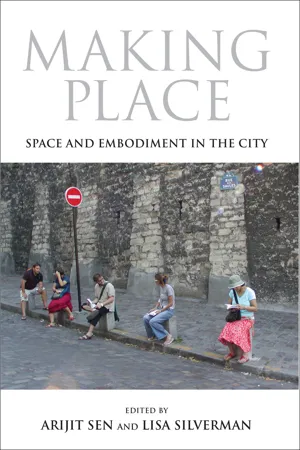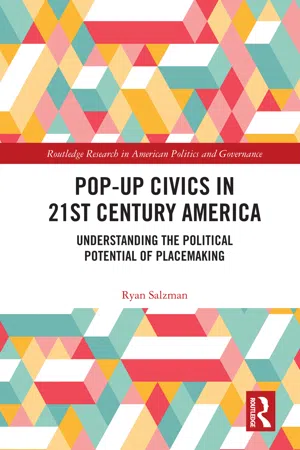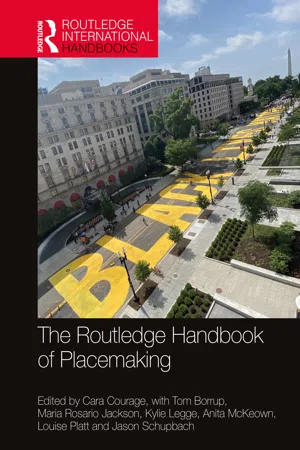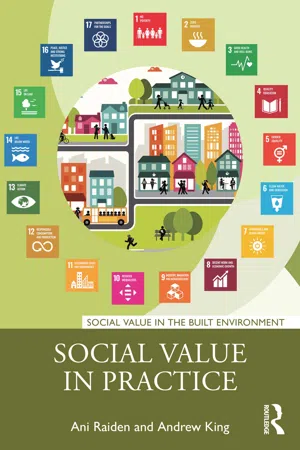Geography
Placemaking
Placemaking refers to the collaborative process of creating public spaces that promote community engagement, health, and well-being. It involves considering the physical, cultural, and social identities of a place to design and manage spaces that reflect the needs and desires of the people who use them. Placemaking aims to enhance the quality of life and sense of belonging within a community.
Written by Perlego with AI-assistance
Related key terms
Related key terms
1 of 4
Related key terms
1 of 3
11 Key excerpts on "Placemaking"
- eBook - ePub
Public Space Design and Social Cohesion
An International Comparison
- Patricia Aelbrecht, Quentin Stevens, Patricia Aelbrecht, Quentin Stevens(Authors)
- 2019(Publication Date)
- Routledge(Publisher)
There is a vested interest in the process of participation and its relation with Placemaking as it can inspire people to collectively reimagine and reinvent public spaces. The ability of Placemaking to strengthen the connection between people and the places they share is regarded as leading to creative patterns of use of spaces and helping negotiate physical, cultural and social identities and maximize shared value (Fleming, 2007). Arefi and Triantafillou (2005) present the ontological constructs of a place as a set of visual attributes, product, process and meaning. In doing so, they argue that Placemaking is the process whereby collective meaning is incorporated into physical design. Placemaking is hence an important tool in community and participatory planning forums, in that it must understand the contemporary social dynamics of people and place relationship (Cilliers and Timmermans, 2014). It has been argued that Placemaking approaches can negate the increasing ‘generic-ness’ of new public space designs (Ferguson, 2014). By involving people in the design process, public spaces can reflect more effectively the culture and people of a place.The newly emerging and increasingly popular community and participatory planning and design approach is the one promoted by the proponents of the Tactical Urbanism movement, one of the trends referred to above associated with the current context of austerity. With short-term, low-cost community-based creative projects, this new type of participatory planning approach has been considered a powerful tool for urban activists and policymakers in the last decade for their potential to drive lasting improvements and build social capital among citizens (Lydon and Garcia, 2015). As Lydon and Garcia (2015) argue, these initiatives offer a way to gain community and political support for investing in projects; they also inspire people and foster the creation of civic leaders to shape urban spaces in a novel way. There is sufficient agreement that the combination of these processes of social engagement, participation and Placemaking are effective approaches to support people to take joint action on everyday experiences at neighbourhood and city level and in fostering social cohesion. There are plenty of examples that demonstrate the numerous benefits of these interventions for cities and their communities, from innovative and cheaper solutions to more socially engaged and stronger citizenship. However, there are still many critics that question the validity and effectiveness of such interventions (Zeiger, 2011; Colomb, 2012; Andres, 2013). Many do not see this type of urbanism as a panacea for the socio-economic problems and changes facing cities and communities or for the past failures of participation. One of the critiques is that, rather than empowering communities, these collaborative endeavours transfer their power to the more structured and dominant organizations; another is that they tend to exacerbate NIMBYist feelings, and therefore promote social cohesion only among the community but not with outsiders. Despite such critiques, the proponents of Tactical Urbanism continue to be enthusiastic and defend their ideas as presenting realistic alternative solutions which are instrumental to keep cities lively and evolving, and to create communities whose interest is to create their collective and gathering spaces (Finn, 2014; Tardiveau and Mallo, 2014). - Sheila McNamee, Mary M. Gergen, Celiane Camargo-Borges, Emerson F. Rasera, , Sheila McNamee, Mary M. Gergen, Celiane Camargo-Borges, Emerson F. Rasera, (Authors)
- 2020(Publication Date)
- SAGE Publications Ltd(Publisher)
This approach has also been growing in the fields of leisure and tourism (Coghlan et al., 2017; Derrett, 2015; Hultman and Hall, 2012), especially among those working in destination management and marketing, promoting the visibility of a destination in more participatory ways. According to Lew (2017), a review of 62 Placemaking publications showed that tourism was a primary focus for 27 (43.5%) of the publications, and was peripheral or non-existent in the others. The focus is usually on public spaces and how people can (or cannot) connect with them, framing, shaping, and creating meaning around that. Placemaking as an approach brings an intentionality into the process of creating this sense of place, the belonging aspects of a place. It is an interdisciplinary approach that grew beyond geography, tourism, or destination management, bringing a participatory approach to increase the livability of a community.The Placemaking goal in general is to design and co-create places and spaces together with the locals that bring a better quality of life to people. It can include a variety of elements: from urban design, focusing more on the physical places such as buildings and schools, to arts and culture, aiming at creating a more vibrant environment, as well as highlighting sustainable businesses which promote financial means for community development. Social goals are usually a great part of Placemaking and one that is quite related to the well-known community building approach.One interesting example of transforming cities and communities through Placemaking is the Project for Public Spaces, working in partnership with the United Nations (www.pps.org/projects ). According to the professionals involved in this project the goal is to revitalize communities through enhancing connections between people and places. Working for more than twenty years, they describe Placemaking as a philosophy and a practice based on participatory processes in which community is actively involved in the democratic decision making. These processes are not preordained; they are dynamic and evolving. Experimentation is key in making what they call ‘lighter, quicker, cheaper’ prototypes, which means solutions that are easy to implement, low-cost, and impact positively on the communities. Another example of Placemaking is the work of the Department of Urban Studies and Planning (DUSP) at MIT, working with Placemaking processes of the 21st century, as they say. That means building social capital by using the available technology of the information age, such as crowd-sourced production, social media platforms, etc., at every level of Placemaking, from publicity and promoting awareness to local agriculture initiatives (community gardens, for instance). The examples above can help incentivize and nurture community building approaches. Community building, however, comes from a different range of disciplines that have been well spread from the Social Work and Psychology fields (Nowell and Boyd, 2010; Townley et al., 2011; Montero, 2002). Community building traditionally aims at promoting social transformation, emphasizing the empowerment of community members and a sense of connectedness. The focus of community building is primarily on individuals (usually vulnerable populations) and how to empower them to fight for their rights and to find opportunities for their communities to develop. Participation is also key in creating strategies and approaching change. The Handbook of Community Psychology- eBook - ePub
Connecting Arts and Place
Cultural Policy and American Cities
- Eleonora Redaelli(Author)
- 2019(Publication Date)
- Palgrave Macmillan(Publisher)
1995 , 2000 ) claim that Placemaking is not just about the relationship of people to their place , it also creates relationships among people in places. “Placemaking is the way all of us human beings transform places in which we find ourselves into places in which we live. It includes building and tearing buildings down, cultivating the land and planting gardens, cleaning the kitchen and rearranging the office, making neighborhoods and mowing lawns, taking over buildings and understanding cities. It is a fundamental human activity that is sometimes almost invisible and sometimes dramatic” (Schneekloth & Shibley, 1995 , p. 1). They also emphasize how Placemaking contributes to a democratic project through the dialogue people engage in during the collaborative process. They even invite architects to engage in this process by moving beyond their sense of expertise. “A practice of architecture implaced within the domain of Placemaking is a move beyond expert culture that does not deny the place of expert knowledges and knowers. […] A resituated project of Placemaking would make of architecture a more relevant and responsible practice through a renewed focus on places as locations for dwelling and through collaborative Placemaking processes as sites for democratic action” (Schneekloth & Shibley, 2000 , p. 138).Placemaking is a concept that emerged from the complaint toward a planning practice that for the aim of efficiency created places disregarding individuals and culture and creating a sense of placelessness . The idea of Placemaking aimed to reclaim a human habitat, where places would encourage social interactions and urban design would consider not only the physical aspects of a place , but the possible activities and ways of interact within it. Later, Placemaking has been studied in its complexity and one aspect that has been emphasized is the need to create community though urban design - eBook - ePub
Arts in Place
The Arts, the Urban and Social Practice
- Cara Courage(Author)
- 2017(Publication Date)
- Routledge(Publisher)
In its broadest sense, Placemaking is the term used by the architectural and planning professions to describe the process of creating the material and social spaces of place so that they are desirable for the public to visit and spend time in (Marshall, 2009; Olin et al., 2008; Uytenhaak, 2008; Wiedenhoeft, 1981). Placemaking recognises that being in a place is an affective and social phenomenon, that sights, sound, environmental factors, ambiance, and imagination all play a role historically and contemporaneously in the making of place and how it is used (Bachelard, in Coglan, 2010; Herbert and Thomas, 1990, p.255) – the sense of place as above. Placemaking holds an assumption of a strong ‘mutually constitutive’ (Watson, 2006, p.6) and positive affect between the built environment and behaviour: as with positive urban experience, public spaces are positioned in a value framework, viewed as essential for urban civility and for creating rich relations between strangers (Sennett, in Watson, 2006, p.14) where people shape the place around them according to their needs and desires (Gotteliener and Hutchinson, 2006, p.18; Watson, 2006, p.8). Place has been ‘rediscovered’ in city thinking (Nicholson, 1996, p.117) and is now viewed as an imperative organising principle in the delivery of spatial policy, especially in times of economic austerity, a product of the discourse of social relations and ‘the promotion of social justice and cohesion, and the delivery of responsible economic development’ (Roberts, 2009, p.441). New forms of cultural Placemaking are being devised and produced by and with creative organisations and citizens, using arts as a means of urban revitalisation and acting at the hyperlocal as a point of intervention and delivery; Placemaking is a ‘critical arena in which people can lay claim to their “right to the city”’ (Silberberg, 2013, p.6), taking place as it does, in the public – and civic – realm.Numerous definitions of Placemaking are found across academic and popular Placemaking literature which converge and diverge in various ways, illustrative of the contestation around issues of place management and analysis (Roberts, 2009, p.439). Placemaking is concerned with the creation or improvement of (predominantly) urban environments that reflect community values and their socio-economic and environmental context (Legge, 2012, p.34). It is an ‘art’ and concerned as much with the function of places as their aesthetic and relationality, its focus on the generative and co-dependent relations between people and the physical environment to ensure the ‘success’ (CABE and DETR 2000, in Sepe, 2013, p.xvi) of places, however success is measured. Global Placemaking agency Project for Public Spaces (PPS) [n.1] defines Placemaking as an ‘overarching idea and a hands-on tool’ (PPS [b]) for urban improvement. The BMW Guggenheim Lab [n.2] stresses the professional constituent cross-cutting inclusive design process of Placemaking (Nicanor and Antilla, 2012), an approach supported by 2007 report from The Social Impact of the Arts Project (SIAP) [n.3] research group at University of Pennsylvania. This report includes an economic imperative in Placemaking, ‘to increase economic opportunity, the quality of public spaces, and investment and development activity in distressed places’ (SIAP, 2007). As a process, for Schneekloth and Shibley (2000, p.132) Placemaking is an active act of both creating and maintaining places through cultural work that ‘allows for multiple standpoints and momentary meanings that facilitate or hinder daily life’. For Silberberg (2013, p.12), this process is similarly fluid and should include multivariate entry points for community participation. Thus, Placemaking is the ‘set of social, political and material processes by which people iteratively create and recreate the experienced geographies in which they live’ and is a networked process ‘constituted by the socio-spatial relationships that link individuals together through a common place-frame’ (Pierce et al., 2011, p.54). It involves participation in both the production of meaning and the means of production of a locale (Lepofsky and Fraser, 2003, p.128) to deliberately shape space to improve a community’s quality of life in place (Silberberg, 2013, pp.1–2). - eBook - ePub
- Stephen McKay, Michael Murray, Stephen McKay, Michael Murray(Authors)
- 2022(Publication Date)
- Routledge(Publisher)
12 Planning and Placemaking
Mura QuigleyDOI: 10.4324/9781003218319-12Introduction
Placemaking as a concept and practice was integrated into spatial planning in the United Kingdom in the 1990s and has since become widespread in its application across towns and cities. The global outbreak of COVID-19 in 2020 has propelled Placemaking to become the focus of attention for making town and city centres more vibrant, authentic and diverse. Originating from the embedding of the social sciences into the public space discourse, its roots can be traced back to studies of public space and life in the 1960s by Jane Jacobs and William ‘Holly’ Whyte. Since that time, Placemaking across the world has accelerated at pace as part of a new cultural regeneration approach, as a way to counter the negative consequences of car domination, and as a return to human-centred development, walkable neighbourhoods and vibrant public spaces.Northern Ireland has not been unaffected by this momentum towards Placemaking. Once considered a peripheral community action, Placemaking has been adopted by the rubric of formal planning in order to articulate a new direction for the profession. Greater awareness of having greener, cleaner, safer and healthier public spaces has gained legitimacy. Alternative narratives for city and town high streets, struggling to adapt beyond retail and to deal with the costs of congestion and air quality, are calling for the strengthening of social cohesion and social capital in order to build local resilience. Nonetheless, progress on the ground has been slow as the priorities for government in the wake of protracted civil conflict continue to be focused on ‘recovering’ rather than ‘transforming’ or ‘adapting’. This has resulted in predominantly top-down, formalised approaches to Placemaking and limited engagement with authentic Placemaking in cities, towns and villages where the private car always wins in the battle for public space. However, with district councils having latterly gained some place-related functions, the green shoots of optimism are emerging that can facilitate more bottom-up community action, a new active citizenship and the creation of places that work for people. Climate and health agendas are helping to shape this trajectory in line with the traction being gained for more availability of local walking and cycling opportunities. - eBook - ePub
Recoded City
Co-Creating Urban Futures
- Thomas Ermacora, Lucy Bullivant(Authors)
- 2016(Publication Date)
- Routledge(Publisher)
Reframing PlacemakingThe professions that form Placemaking alliances today include urban design, urban planning, landscape architecture, engineering, geology, agricultural engineering, social science, ethnology and activism – as well as liveability research, as tough as it is to pin down the full meaning of ‘liveability’ in the context of cities. Working for clients in the public sector and, increasingly, the private sector too, these multidisciplinary battalions’ common modes of operation today include zoning of land uses; masterplanning is deployed in various guises, sometimes more as a conceptual framework, and public space regeneration and landscape schemes are applied to a mix of goals, commercial motives being predominant.Responses are made, as well, to overall governmental growth strategies, to the requirement to accommodate and decentralise populations in order to meet environmental agendas. Considerations need to be given to economic and carbon costs, and performance criteria, as well as to the creation of benchmarks against international exemplars. But set against this noble picture of holistic procedures, it remains a fact that the traditionally reforming dynamic of urban design is today tempered by too much compromise in favour of expedient solutions, rather than socially beneficial ones. Yet urban design possesses so much potential of social value that it is no surprise that alternative means of advancing urban Placemaking for people – as opposed to statistics – are a justified central focus of this book.In-situ housing prototype built by Urban-Think Tank and NGO Ikhayalami as part of U-TT’s Empower Shack R&D project, Khayelitsha township, Cape Town, 2012- (page 266). Ikhayalami/ Empower Shack. - eBook - ePub
Place-making and Urban Development
New challenges for contemporary planning and design
- Pier Carlo Palermo, Davide Ponzini(Authors)
- 2014(Publication Date)
- Routledge(Publisher)
Chapter 2 .2.2 Place-making in real estate developmentGoals and effectsActual real estate development processes can be the most immediate area for empirical evidence. In fact, place-making could be considered a natural corollary to routine processes in this field (Haight and Singer, 2005, Peca, 2009, Lall et al., 2009) that render a property more attractive on the market: by innovating construction methods and making it more sustainable but also by guaranteeing the overall improvement of the built environment as an important factor in economic value. This means recognizing three immediate place-making functions in urban development processes: market value, product innovation, and territorial marketing.A first possible goal could be to reinforce building models that have already been tested on the market through site enhancement or the improvement of privacy and safety; these are often traditional interventions that tend to reproduce specific kinds of urban settlements, such as some suburban areas much appreciated by the upper middle classes (Ward, 1998). Another goal of undeniable interest is the attempt to modify building quality from the point of view of technology and construction systems, developing innovative ideas and techniques that can achieve environmental sustainability (with effects that are significant or sometimes only cosmetic: Frumkin et al., 2004, Kahn, 2006, Cooper et al., 2009, Newman et al., 2009, Flannery and Smith, 2011, Pickert et al., 2013). In general, place-making can be associated with territorial marketing initiatives that tend to modify not only buildings’ formal and technological features but also affect the very image of urban space above and beyond the single building (Smyth, 1994, Keeping and Shiers, 2004). This orientation is often associated with the attempt to impose a preconceived idea of urban settlement on the market – even if the most widespread rhetoric continues to celebrate the role of the subjects involved. In fact, the most successful experiences tend to confirm well-established settlement patterns that descend from long-standing ideal-types, especially the Garden City and the Radiant City, models that, according to some, have potentially anti-urban - eBook - ePub
Making Place
Space and Embodiment in the City
- Arijit Sen, Lisa Silverman(Authors)
- 2014(Publication Date)
- Indiana University Press(Publisher)
9Movement and Walking
Other theorists have emphasized the importance of movement in Placemaking, conceptualizing space as movement rather than a container.10 For example, the geographer Allan Pred traces the history of microgeographies of daily life in southern Sweden to determine how everyday movement and behavior generate spatial transformations in land tenure that result in changes in the local social structure. He concludes that place always involves “appropriation and transformation of space and nature that is inseparable from the reproduction and transformation of society in time and space,” and he demonstrates how social change occurs through everyday bodily practices.11 Michel de Certeau's insightful analysis of the spatial tactics of orientation and movement also focuses on how the mundane acts of walking and meandering resist state order and regimes of city planning.12John Gray, in his ethnographic research on sheep herding in the Scottish borderlands, draws inspiration from de Certeau by emphasizing the analogy of walking and language, with walking designated as the equivalent of speaking (la parole), rather than language (la langue) and the appropriation of space. Like de Certeau's urban dwellers, the hirsel, a unified place that includes both a shepherd's sheep and their grazing area, is constituted by the shepherd's walking and biking in the hills to care for his animals. The act of shepherding, or “agoing” around the hill, is a kind of space-making requiring a shepherd's detailed knowledge of not only the terrain but also how the sheep bond to parts of the terrain, and how these parts are linked together by paths to form a hirsel. The emphasis on walking the hills demonstrates how places, which may be separately named and recalled, are connected to one another and form a unified whole.13 - eBook - ePub
Pop-Up Civics in 21st Century America
Understanding the Political Potential of Placemaking
- Ryan Salzman(Author)
- 2020(Publication Date)
- Routledge(Publisher)
A synonym for protest is demonstration. Thinking about demonstrations instead of protests provides two important insights for theory-building. First, it undercuts the tendency to think of protest as a potentially violent political behavior. Second, the word “demonstration” is an essential term for many Placemaking events. Pop-up Placemaking is a demonstration of something that could be permanent. Pop-up bicycle lanes demonstrate how permanent bicycle lanes might work on a road. Pop-up markets demonstrate that a vacant storefront could be the anchor of a vibrant commercial district. Community gardens demonstrate the reasonableness of neighbors coming together to grow food. Parklets demonstrate creative uses for parking spaces and elevate the value of art in the community. The list goes on and on, highlighting the essence of the power of Placemaking: demonstration.The importance of Placemaking as demonstration was consistently touched on by interviewees at every stage of this research project. The sentiment was always “how can the desire of the community be known without efforts to convey those desires?” Although that is a rather obvious line of reasoning for policymakers, it is decidedly difficult to do if you are a member of the community. In fact, it is my experience that bureaucrats and public officials often use “show me” as a weapon against individuals pushing for change. Nonetheless, interviewees repeatedly and genuinely advocated for the demonstrating power of Placemaking that accounts for three of the polyarchy requisites discussed in Chapter 2 : enlightened understanding, setting the agenda, and effective participation (Dahl 1998). “It’s grassroots saying here’s what we want our community to look like,” said one high-level bureaucrat, “and it really helps the city because we don’t know.” The leader of a CBO distilled the potential of Placemaking to act as a conduit between community wants and policymaking. “There’s wisdom in neighborhoods… . You’re a fool if you don’t tap into that wisdom to make decisions… . Government should structure itself to receive that input.” Of course, one might expect a nonpublic servant to say that, but the agreement between these two individuals involved in policymaking – a public servant and a community leader – is notable. Another public servant perfectly captured the idea of Placemaking as protest. “Disruption is at the core… . If you don’t want to change things, why do it?”Political behaviors focus on policy change. Sometimes the point of the behavior is to prevent change, protecting the status quo. Many times it is about altering the status quo by inducing change. Regardless of whether political action is about causing or preventing policy change, in order to realize that outcome, it is necessary that the political action influence the preferences of individuals with the power to actually carry out (or prevent) the policy change. This is the broad process known as “policy responsiveness,” and it is through that process that the demands of individuals, groups, and society are translated into public policy. - eBook - ePub
- Cara Courage, Tom Borrup, Maria Rosario Jackson, Kylie Legge, Anita Mckeown, Louise Platt, Jason Schupbach, Cara Courage, Tom Borrup, Maria Rosario Jackson, Kylie Legge, Anita Mckeown, Louise Platt, Jason Schupbach(Authors)
- 2020(Publication Date)
- Routledge(Publisher)
Husam AlWaer and Ian CooperChapter 39 : Translating Outcomes: Laying the groundwork for interdisciplinary evaluation of creative PlacemakingJamie HandChapter 40 : Transforming community development through arts and culture: a developmental approach to documentation and researchVictor RubinChapter 43 : A theory of change for creative Placemaking: the experience of the National Endowment for the Arts’ Our Town program: an interview with Patricia Moore Shaffer, PhDMaria Rosario JacksonChapter 44 : Creative Placemaking and comprehensive community development: rethinking neighborhood change and evaluationMaria Rosario JacksonPassage contains an image
Lisa Eckenwiler30 Ethical Placemaking for ecological subjectsIn this chapter I propose that we embrace an ecological conception of persons and, from there, go on to argue that we should understand the fundamental goal of governance in terms of ‘ethical Placemaking.’ Next, I suggest considerations that should guide thinking about governance aimed at generating more livable, equitable futures for ecological subjects through Placemaking and call for ecological communicative democracy. In the final section, I identify the ethical and political capacities that ought to characterize ecological subjects and conclude by reiterating the central place of care and places of care in nurturing them.Ecological subjects-citizens
The independent human being of reason, a conceived being in terms of self-interested calculation and material acquisition who is traceable through Plato, Augustine, Descartes, and Locke (Taylor, 1989), has been subjected to considerable critique in contemporary philosophy. As feminist and other philosophers, such as Communitarians have argued, this idealized account of persons, with its undue emphasis on independence and rationality, ignores the significance of social structures and the body in our lived experience and shaping of our identities, and obscures our interdependence with others in filial and communal bonds, and essential need for relations of nurturing and care (Sandel, 1992; Tronto, 1994; Meyers, 1997; Kittay, 1999). - eBook - ePub
- Ani Raiden, Andrew King(Authors)
- 2021(Publication Date)
- Routledge(Publisher)
Above all, these spaces should create a space for people of diverse social, cultural, and economic groups, of different ages and orientations, to come together and better understand each other’s needs and aspirations, and to identify shared values and objectives as their foundation for shaping their environment. Placemaking serves a civic purpose and can unlock social value for many if its design is inclusive, empowering, and above all, collaborative.Social value and community heritage – Andrew Langley
Focusing on the community of Caribbean descent in Nottingham, the ‘Perceptions of Heritage’ project used ideas of community heritage to enhance connections to the built environment. During a series of workshops, participants were encouraged to draw and write about activities they considered significant to their culture. These drawings and memories were displayed during a public exhibition, allowing conversations to continue into the broader community. Discussion of heritage and value creation within the built environment is currently dominated by monumentally grand and aesthetic sites and places (Arizpe, 2000 ; Cleere, 2001 ; Meskell, 2002 ). This project aimed to challenge what Smith (2006 ) describes as the Authorised Heritage Discourse by focusing on intangible heritage, which is ‘deeply rooted’ within communities and attached to the local geography that they live in (Cominelli and Greffe, 2012 ). Consequently, the community within Nottingham was placed at the heart of the project.During the multiple workshops and exhibitions, conversations between the participants initially revolved around the co-created drawings of activities. Conversations then developed to focus on memories of the spaces and places in which these activities took place. The shared memories of activities and community involvement within the spaces helped to further connect people to place. Working collaboratively with the community over the two and a half years, social value was created as the process enhanced a sense of ‘integration, contribution and belonging to normal society’ (after Raiden et al., 2019 ).The study revealed that sharing community memories and encouraging conversations in the form of participatory exhibitions contribute to developing a place identity from the bottom-up. The project highlighted the potential of this method to understand the intangible heritage of any community and to create social value within the existing built environment. It also revealed the potential of this understanding to be applied within the design phase of new build projects – for example, Placemaking from the bottom-up for areas that are undergoing regeneration.
Index pages curate the most relevant extracts from our library of academic textbooks. They’ve been created using an in-house natural language model (NLM), each adding context and meaning to key research topics.
Explore more topic indexes
Explore more topic indexes
1 of 6
Explore more topic indexes
1 of 4
